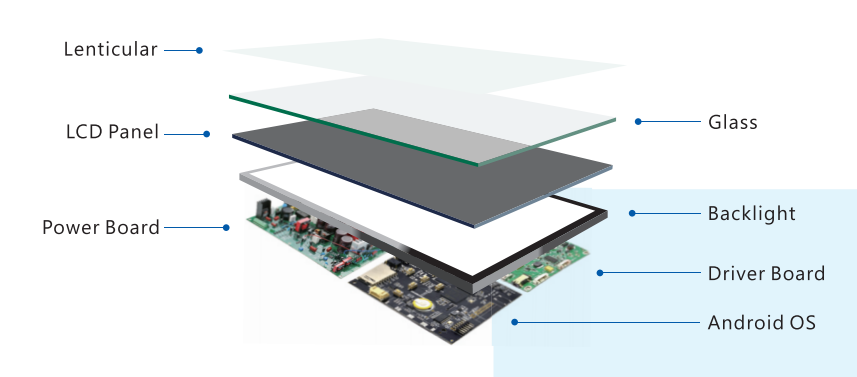With the rapid development of science and technology, 3D LCD grating display technology is constantly subverting our traditional visual experience. Whether it is used in smartphones, tablets, laptops, or advertising displays, 3D LCD grating displays have shown amazing application prospects. This article will comprehensively interpret the modern scientific and technological technology of 3D liquid crystal grating display from the two aspects of core technical advantages and parameters.
Core technical advantages of 3D LCD grating display
The reason why 3D LCD grating displays stand out is inseparable from its four core advantages.
- Eye tracking technology
The 3D LCD grating display captures the user’s eye position through the front camera and customizes a reasonable perspective in real-time according to the eye position and pupil distance. This technology not only enhances the user’s immersion but also avoids the visual fatigue that traditional 3D devices may cause. With this technology, 3D LCD grating displays truly realize a “people-oriented” personalized visual experience.
- Professional layout algorithm optimization
The 3D LCD grating display is equipped with an enhancement algorithm that adapts to a variety of pixel structures and can support 30 different pixel arrangements. Moreover, its color compensation algorithm and left-right view crosstalk compensation algorithm significantly reduce the crosstalk phenomenon in 3D display, while eliminating common moiré patterns. As a result, users can enjoy a low-crosstalk, interference-free, and extremely comfortable visual feast.
- Cloud-based 2D to 3D technology
Through cloud processing, the 3D LCD grating display has the powerful ability to convert 2D images into 3D content. Its core technologies include 2D image depth relationship recognition and hole-filling technology, which make the converted 3D mode not only have a real three-dimensional sense but also have no loss in brightness.
- Real-time 2D to 3D function
In devices using 3D LCD grating displays, users can even take photos or videos with their mobile phones and immediately convert 2D content into 3D content. This technology supports one-click switching of 2D/3D display, and in 2D mode, the device resolution is completely lossless, maintaining native clarity.

3D LCD grating display parameters
Demonstrating advanced technological strength – from display size to resolution, every detail has been carefully designed to ensure users get the best viewing experience.
- Display sizes: 58 inches, 12.2 inches, and 15.6 inches are available to meet a variety of needs from mobile devices to desktop displays.
- Viewing angle range: 120° horizontal viewing angle and 60° vertical viewing angle, allowing users to watch from multiple angles without any visual restrictions.
- Resolution: Supports three resolutions of 1080×2408, 2560×1600, and 3840×2160. Whether it is HD or UHD quality, the 3D LCD grating display can easily handle it.
- Pop-up/Depth: The display depth range is 15-50 cm, creating a more realistic stereoscopic effect for users.
- Supported systems: Compatible with Windows, Android, and iOS systems, with good cross-platform adaptability.
- Applicable products: Including 3D mobile phones, 3D tablets, 3D laptops, 3D desktop displays and 3D advertising displays, covering a wide range of application scenarios in consumers’ daily lives.
Conclusion
In the future, 3D LCD grating displays are bound to become the mainstay of display technology, bringing more surprises to users! As the representative of future display technology, 3D LCD grating displays not only change the way we see the world but also lead a visual revolution.
From eye tracking to cloud 2D to 3D conversion to real-time conversion, the core advantages and excellent performance of 3D LCD grating displays ensure their huge potential in the consumer market and commercial applications. If you are looking for a technology product that can bring revolutionary improvement to the visual experience, 3D LCD grating displays are undoubtedly the best choice.





